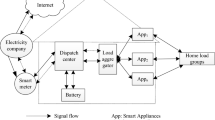Abstract
The demand response model of household microgrid based on satisfaction of customers is proposed after the users’ habit of using electricity which is found from the historical electricity data and aims at the problems of the load diversity of the household microgrid and the improvement of user satisfaction in response process, combined with the demand response theory of the users and the thought of data mining. The demand response strategy model based on users’ satisfaction is designed with the research of demand response behavior integrated with user’s side experience. The model takes the user's demand responsiveness as the load constraint, takes user’s comprehensive satisfaction maximum as the demand response objective, and takes the bacterial colony chemotaxis hybrid algorithm to solve the model. Finally, the optimal load power consumption plan is obtained as the user’s demand response strategy. The experimental simulation results verify the energy-saving effect of the model and the effectiveness of the algorithm.
Access this chapter
Tax calculation will be finalised at checkout
Purchases are for personal use only
Similar content being viewed by others
References
Zhang, Y., Rong, Z.P., Zhan, Y.X., Hu, H.Z., Zhao, J., Wei, M.: Study of grid demand response based on micro grid. J. Power Syst. Prot. Control 21, 20–26 (2015)
Yin, Z., Che, Y., Li, D., Liu, H., Yu, D.: Optimal scheduling strategy for domestic electric water heaters based on the temperature state priority list. J. Energies 10, 1425 (2017)
Zeng, B., Yang, Y.Q., Duan, J.H., Zeng, M., Ouyang, S.J., Li, C.: Key issues and research prospects for demand-side response in alternate electrical power systems with renewable energy sources. J. Autom. Electr. Power Syst. 17, 10–18 (2015)
Park, L., Jang, Y., Bae, H., Lee, J., Park, C.Y., Cho, S.: Automated energy scheduling algorithms for residential demand response systems. J. Energies 10, 1326 (2017)
Yu, H., Liu, Z., Li, C., et al.: Study on pricing mechanism of cooling, heating, and electricity considering demand response in the stage of park integrated energy system planning. MDPI 10(5) (2020).
Vuelvas, J., Fredy, R.: A novel incentive-based demand response model for Cournot competition in electricity markets. Energy Syst. 10(1) (2019).
Wang, F., Zhang, Z., Liu, C., et al.: Generative adversarial networks and convolutional neural networks based weather classification model for day ahead short-term photovoltaic power forecasting. Energy Convers. Manag. 181 (2019).
Ghayekhloo, M., Azimi, R., Ghofrani, M., et al.: A combination approach based on a novel data clustering method and Bayesian recurrent neural network for day-ahead price forecasting of electricity markets. Electr. Power Syst. Res. 168 (2019).
Acknowledgements
This work are supported by the Science and Technology Development Projects of Jilin Province of China (grant numbers: 20180101335JC, 20180201092GX and 20170204002GX).
Author information
Authors and Affiliations
Corresponding author
Editor information
Editors and Affiliations
Rights and permissions
Copyright information
© 2021 The Author(s), under exclusive license to Springer Nature Singapore Pte Ltd.
About this paper
Cite this paper
Guo, X., Sun, Y., Feng, L., Qu, C., Sun, T. (2021). Demand Response Strategy Model Based on User Satisfaction. In: Pan, JS., Li, J., Namsrai, OE., Meng, Z., Savić, M. (eds) Advances in Intelligent Information Hiding and Multimedia Signal Processing. Smart Innovation, Systems and Technologies, vol 211. Springer, Singapore. https://doi.org/10.1007/978-981-33-6420-2_46
Download citation
DOI: https://doi.org/10.1007/978-981-33-6420-2_46
Published:
Publisher Name: Springer, Singapore
Print ISBN: 978-981-33-6419-6
Online ISBN: 978-981-33-6420-2
eBook Packages: Intelligent Technologies and RoboticsIntelligent Technologies and Robotics (R0)




